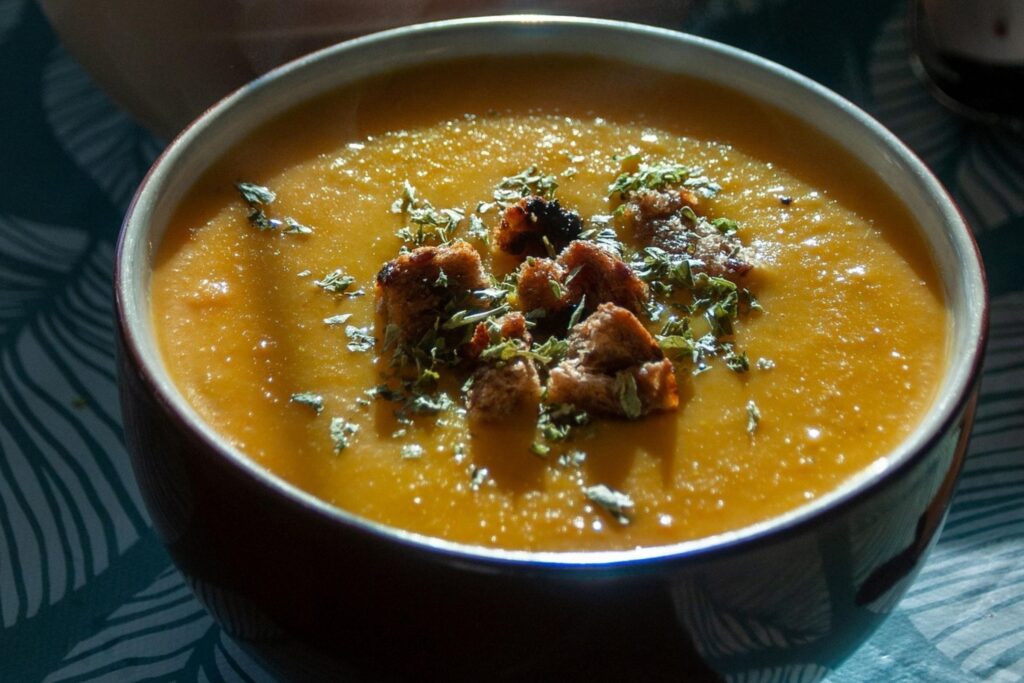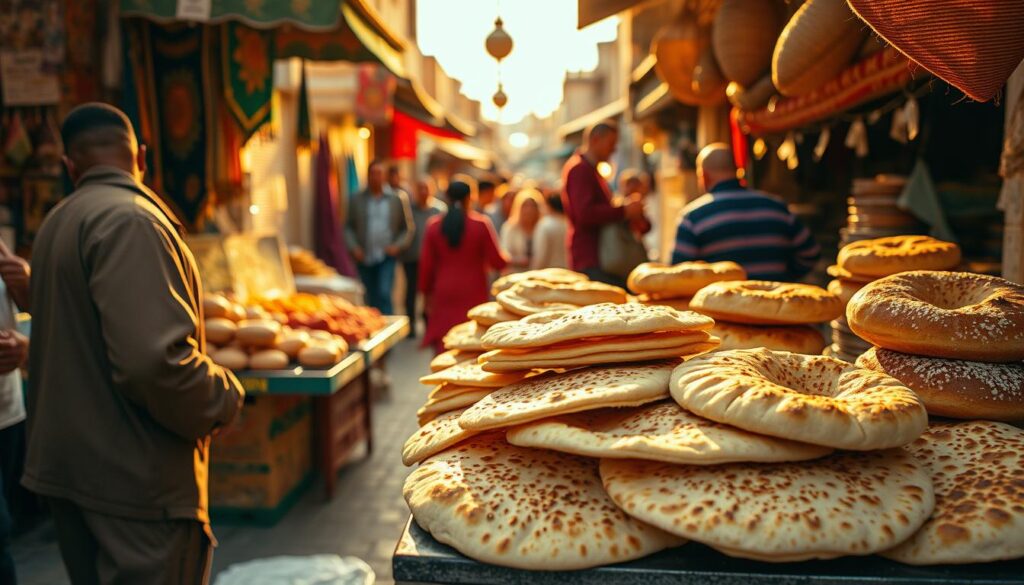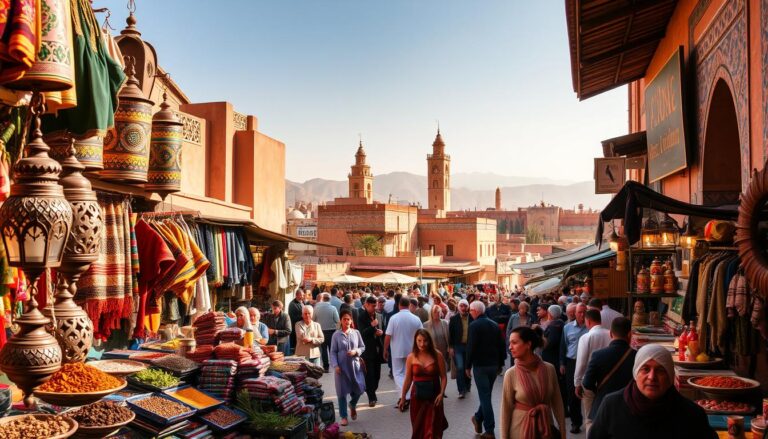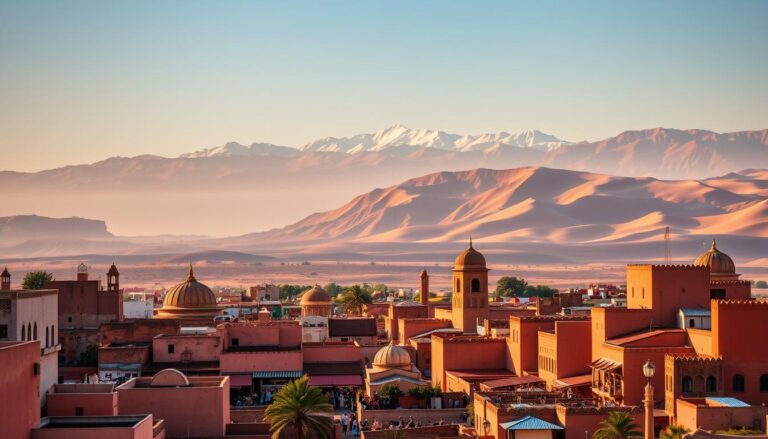Deliciously Common Moroccan Foods You’ll Fall in Love With
The first time I tasted authentic Moroccan food, it was like a sensory explosion. It took me on a journey through centuries of culinary tradition. The vibrant spices, rich textures, and complex flavors told stories of trade routes and cultural exchanges.
Moroccan cuisine is a remarkable culinary journey. It combines Berber, Arab, Mediterranean, and North African influences. These common Moroccan foods are not just meals. They are edible narratives of cultural heritage, made with love and deep-rooted traditions.
From fragrant tagines to delicate pastries, each dish is a unique chapter in Morocco’s gastronomic story. The country’s diverse landscapes have shaped its extraordinary food culture. From coastal regions to mountain ranges and desert territories, each landscape has its own flavor.
Table of Contents
Key Takeaways
- Moroccan cuisine blends multiple cultural influences
- Spices play a crucial role in traditional cooking
- Each dish tells a story of cultural heritage
- Moroccan food reflects geographic diversity
- Cooking techniques are passed through generations
A Journey Through Traditional Moroccan foods
Moroccan cuisine is a colorful mix of flavors. It combines centuries of cultural influences, making some of Morocco’s most famous dishes. The food scene shows the rich history of Berber, Arab, and Mediterranean traditions.
The secret of Moroccan recipes is turning simple ingredients into amazing dishes. This journey shows how different cultures have influenced Morocco’s cooking style.
Cultural Culinary Influences
Moroccan cuisine comes from a mix of cultures. The Berber people brought basic cooking techniques. Arab traders introduced spices and new ingredients. Mediterranean trade added seafood and olive oil methods.
- Berber: Introduced slow-cooking methods
- Arab: Contributed sophisticated spice blends
- Mediterranean: Added seafood and olive oil techniques
Essential Spices in Moroccan Cooking
Spices are the heart of Moroccan recipes. Each blend tells a story of cultural exchange and creativity.
- Ras el Hanout: A complex spice mixture with up to 30 ingredients
- Cumin: Adds warmth and depth to dishes
- Saffron: Provides distinctive color and flavor
- Paprika: Brings subtle heat and richness
Traditional Cooking Methods
The famous food of Morocco is made with old techniques. These methods keep flavors and nutrients alive.
- Tagine cooking: Slow-steaming in clay pots
- Couscous steaming: Delicate grain preparation
- Open-fire roasting: Traditional meat preparation
These cooking methods turn simple ingredients into amazing dishes. They show Morocco’s deep-rooted culinary traditions.
The Art of Moroccan Tagine: A Culinary Masterpiece
The tagine is more than a cooking method in Moroccan cuisine. It’s a clay pot with a unique cone-shaped lid. For centuries, it has turned simple ingredients into amazing dishes.
The traditional tagine pot cooks food in a special way. Its design lets steam circulate and condense. This makes the food moist and full of flavor. Moroccan cooks use it to make tender meats, colorful vegetables, and complex spice mixes.
- Clay construction enables slow, even heat distribution
- Cone-shaped lid captures and recycles cooking moisture
- Versatile for meat, vegetarian, and seafood preparations
Different parts of Morocco have their own tagine styles. Coastal areas might use seafood, while mountain regions prefer lamb and root vegetables. Each tagine shares a story of local ingredients and traditions.
| Tagine Type | Primary Ingredients | Regional Origin |
|---|---|---|
| Chicken Tagine | Preserved lemons, olives | Urban Centers |
| Lamb Tagine | Dried fruits, almonds | Mountain Regions |
| Vegetable Tagine | Seasonal vegetables, spices | Nationwide |
Today, chefs around the world love the tagine. They see how it makes delicious meals with little effort. From fancy restaurants to home cooks, the tagine keeps inspiring new recipes.
Couscous: The Crown Jewel of Moroccan Food Dishes
Couscous is the heart of North African cuisine. It’s a staple in Moroccan kitchens for centuries. It’s more than a meal; it’s a celebration of flavor and community.
Couscous is made from tiny steamed semolina wheat granules. When prepared right, it becomes light and fluffy. Its versatility lets it be enjoyed in many ways across Morocco.
Types of Couscous Preparations
Moroccan cuisine has many couscous styles:
- Tfaya Couscous: Topped with caramelized onions and raisins
- Vegetable Couscous: Loaded with seasonal produce
- Meat Couscous: Featuring lamb, chicken, or beef
- Fish Couscous: Popular in coastal regions
Traditional Friday Couscous Ritual
Friday is special in Moroccan culture. Families come together for a communal couscous meal. This turns couscous into a sacred tradition that strengthens family bonds and celebrates togetherness.
Serving and Eating Etiquette
Eating couscous has its own rules:
- Use right hand for eating
- Form small balls of couscous
- Eat from a communal dish
- Respect elders’ serving order
“Couscous is not just food; it’s a celebration of Moroccan heritage.” – Moroccan Culinary Tradition
Harira: Morocco’s Beloved Soup

Harira soup is a key part of Moroccan food, deeply tied to tradition and culture. It’s more than just food; it’s a big part of Moroccan identity. During Ramadan, it’s especially important, helping to break the fast.
The ingredients of harira soup show Morocco’s rich food culture. It usually has:
- Tender lamb or beef
- Chickpeas
- Lentils
- Tomato base
- Fragrant spices like turmeric and cinnamon
Harira soup is very nutritious. It has proteins, legumes, and spices, giving important nutrients and warmth. Families across Morocco make this soup in their own way, adding their special touch.
| Ingredient | Nutritional Benefit |
|---|---|
| Lamb/Beef | High protein content |
| Chickpeas | Fiber and plant-based protein |
| Lentils | Iron and complex carbohydrates |
| Tomatoes | Vitamin C and antioxidants |
“Harira is not just a soup, it’s a celebration of Moroccan culinary heritage” – Moroccan Food Historian
Harira soup is loved around the world, not just in Morocco. Restaurants and home cooks everywhere enjoy this classic Moroccan dish. It brings a taste of North Africa to tables everywhere.
Bastilla: The Sweet and Savory Delicacy
Bastilla is a true gem in Moroccan cooking, showing the art of food at its best. It mixes sweet and savory tastes in a flaky pastry. This dish is loved by food lovers all over the world.
This dish comes from the royal kitchens of Morocco. It’s known for its perfect mix of flavors and textures. The pie has layers of thin pastry filled with seasoned meat.
Traditional vs Modern Variations
Old bastilla recipes used pigeon meat. But now, you can find:
- Chicken as a popular choice
- Seafood for those by the coast
- Vegetarian options with legumes
Special Occasion Significance
Bastilla is more than food; it’s a celebration. Moroccans enjoy it at weddings, festivals, and family gatherings. It shows their love for hospitality and cooking.
“Bastilla represents the soul of Moroccan cooking – complex, layered, and absolutely delicious.” – Moroccan Chef Fatima El Kadiri
Step-by-Step Preparation
Making real bastilla takes time and care. Here’s how to do it:
- Make a seasoned meat filling
- Make thin warqa pastry
- Layer meat between pastry sheets
- Bake until it’s golden and crispy
- Dust with powdered sugar and cinnamon
Today’s chefs keep bastilla fresh and exciting. They make sure it stays a favorite dish.
Street Food Favorites: From M’semen to Khobz

Morocco’s street food is full of flavor and tradition. It offers a tasty look into the country’s food heritage. M’semen and khobz are key street foods that show the heart of Moroccan cuisine.
M’semen is a flaky flatbread that’s a street food wonder. Vendors make it by:
- Folding thin dough many times
- Cooking it on a hot griddle until it’s golden
- Serving it fresh and crispy
Khobz, the traditional Moroccan bread, is a must in every street market and home. It’s round and dense, perfect with tagines, soups, and street food. People enjoy khobz with:
- Olive oil and salt
- Harissa paste
- Fresh vegetable salads
But Moroccan street food is more than just m’semen and khobz. Small food stalls and lively markets offer a wide range of tasty bites. Each bite tells a story of cultural mix and old cooking ways.
“Street food is the heartbeat of Moroccan cuisine, connecting generations through shared flavors and cooking traditions.”
For real Moroccan food experiences, check out these street food gems. Every bite shows the true taste of Moroccan food.
Zaalook and Other Essential Moroccan Salads
Moroccan food is known for its bright flavors and colorful dishes. Zaalook, a traditional eggplant salad, is a standout. It’s loved for its smoky taste and easy making.
Zaalook is more than a side dish in Moroccan food. It shows the country’s love for fresh veggies and strong spices. Made with roasted eggplants, tomatoes, garlic, and spices, it introduces you to Moroccan tastes.
Popular Vegetable Combinations
Moroccan salads offer a wide range of veggie mixes. They excite your taste buds. Some favorites include:
- Roasted eggplant with tomatoes and paprika
- Chopped bell peppers with cilantro
- Carrots seasoned with cumin and olive oil
- Beetroot with garlic and parsley
Serving Suggestions and Pairings
Zaalook and other Moroccan salads are very flexible. They can be:
- Appetizers before main courses
- Side dishes with grilled meats
- Accompaniments to fresh bread
- Dips for traditional Moroccan flatbreads
| Salad Type | Key Ingredients | Best Pairings |
|---|---|---|
| Zaalook | Eggplant, Tomatoes, Garlic | Grilled Lamb, Couscous |
| Carrot Salad | Carrots, Cumin, Olive Oil | Chicken Tagine |
| Pepper Salad | Bell Peppers, Cilantro | Fish Dishes |
To make zaalook, roast the eggplants until they’re dark. This smoky flavor is key. Try different spices and serve at room temperature for the best taste.
Sweet Delights: Chebakia and Moroccan Pastries
Morocco’s food scene is filled with sweet treats that warm the heart. Chebakia is a standout, especially during Ramadan. It shows the deep cultural roots of Moroccan sweets.
Chebakia is a honey-coated sesame cookie that turns simple ingredients into magic. It’s made by folding dough into a rose-like shape. Then, it’s deep-fried and covered in honey and sesame seeds.
- Preparation involves carefully folding and shaping dough
- Deep-fried until golden brown
- Soaked in fragrant honey
- Sprinkled with toasted sesame seeds
Moroccan pastry culture is rich with sweet delights. These pastries, like almond-based ones and fruit-infused desserts, add to the joy of mint tea.
These sweets are more than food; they celebrate Moroccan hospitality and tradition. Each bite shares a story of family recipes and the magic of turning simple ingredients into something special.
“In Morocco, desserts are more than just a meal’s end—they’re a cultural expression.”
For Moroccans, sweetness is an art form. Chebakia is the crown jewel of this tradition.
Rfissa: A Comforting Traditional Dish
Rfissa is a beloved dish in Morocco, showing the country’s warm hospitality. It’s more than food; it’s a symbol of love and care in Moroccan families.
The classic rfissa has special ingredients:
- Shredded msemen or day-old bread
- Tender chicken pieces
- Nutritious lentils
- Aromatic spices like fenugreek, ginger, and saffron
Rfissa is especially meaningful for new mothers. It’s a nutritious meal that helps them recover and regain strength. The dish combines protein, fiber, and spices for healing.
“Rfissa is not just a dish, it’s a gesture of love and support in Moroccan culture.”
Making rfissa takes time and skill. Cooks layer the ingredients carefully, blending flavors for a rich, satisfying meal. It showcases Moroccan culinary artistry.
| Ingredient | Nutritional Benefit |
|---|---|
| Chicken | High protein, supports muscle recovery |
| Lentils | Rich in fiber, supports digestive health |
| Fenugreek | Aids lactation, supports metabolism |
| Msemen | Provides complex carbohydrates, energy source |
Though rfissa may not be well-known worldwide, it embodies Morocco’s culinary spirit. It shows how food can heal, connect, and express love.
Regional Variations and Specialties
Moroccan recipes show a rich culinary world shaped by different places. From coastal towns to desert areas, each spot adds special flavors and ingredients to Morocco’s famous dishes.
The food traditions of Morocco are a mix of many cultures. This mix shows the country’s wide range of tastes.
Northern Moroccan Cuisine
Northern Morocco is influenced by the Mediterranean and Spain. This makes its dishes different from other parts of the country. Ingredients like olives, citrus, and seafood are common here.
- Seafood-rich dishes with Rif Mountain herbs
- Lighter cooking styles compared to southern regions
- Strong Spanish and Andalusian culinary influences
Coastal Specialties
Coastal areas are all about fresh seafood. Places like Essaouira and Casablanca are known for their seafood dishes.
“The ocean’s bounty transforms every meal into a celebration of flavor” – Moroccan Coastal Chef
- Grilled sardines with chermoula sauce
- Seafood tagines with saffron
- Fresh fish prepared with traditional spice blends
Saharan Influences
The desert areas have hearty dishes that reflect survival and trade traditions. Dried meats, preserved ingredients, and slow-cooking are key to Saharan cuisine.
- Lamb and camel meat preparations
- Hearty stews with minimal water
- Spices that preserve and enhance flavors
Each region has its own food story, making Morocco a delicious journey.
Conclusion
Moroccan food dishes are a colorful mix of flavors, history, and culture. From Marrakech’s aromatic tagines to Casablanca’s street food, Moroccan cuisine is a story of innovation and tradition. Each dish shows the depth of Morocco’s food heritage, blending Berber, Arab, and Mediterranean flavors.
Moroccan cuisine is more than just ingredients. It’s about community, family, and old cooking ways. Dishes like couscous, harira, and bastilla show the unique layers of flavor and skill. The mix of spices, slow cooking, and sharing meals make Moroccan food special.
For those who love food and culture, Moroccan cuisine is an exciting discovery. Whether cooking a tagine at home or eating at a Moroccan restaurant, every bite connects you to a rich tradition. Moroccan cooking is not just about food; it’s about celebrating life, culture, and shared moments.
Exploring Moroccan food is a journey through history, geography, and the human spirit. Each recipe has a story, each spice a memory, and every meal connects us to generations of cooks. These traditions are preserved and evolved by passionate cooks.



